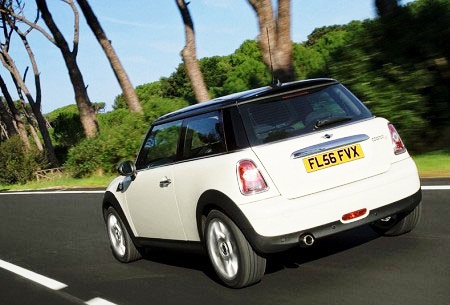Has the Bangkok traffic for many years had the answer to fuel economy? Sit in any of Bangkok’s thousands of taxis and watch the driver turn off the engine when held in traffic. The simplistic approach being that the vehicle uses no fuel when the motor is turned off, therefore the fuel economy improves.
Bosch is now doing this electronically. Called “Idle-stop” it switches off a petrol engine when the vehicle comes to a halt and re-starts it when the driver is ready to move off. (Bangkok’s taxi drivers currently do this manually with the ignition key.)
 Mini Cooper D
Mini Cooper D
Bosch is very sure that this fuel-saving technology will become standard fitment in Europe, with an 85 percent take-up by 2014. Already, this technology is being used in some models by Toyota, Citroen, Fiat, BMW, Mini, Hyundai, Mazda, Kia, Mercedes and Volkswagen, and available in some areas of the world. One example of the fuel consumption that can be recorded with idle-stop is in the Mini Cooper D, a diesel model that uses just 3.9 L/100 km.
Bosch claims that it might seem like pure electric is not far away, but in their point of view it will not come tomorrow – there is still a long way to go with the combustion engine.
Other fuel saving improvements would include smaller capacity engines with turbo or supercharging, cylinder deactivation, variable valve actuation, improved ignition control, direct injection, better exhaust gas treatment including re-circulation and better transmission controls.
Bosch predicts petrol and diesel engines will still dominate sales around the world in 2016. Its data suggests hybrids will grow, but will not outsell ethanol flex fuel and LPG/CNG in Europe and the US.
An example of this stop-start technology is used in the Honda Insight Hybrid. To prevent unnecessary fuel consumption and exhaust emissions, the Insight’s gasoline engine is turned off when there is no need for propulsion or air conditioning. During typical deceleration, the regenerative braking and fuel cut mode begin as soon as the driver begins to decelerate. When the engine speed slows down to about 1000 rpm, regenerative braking will stop, and the driver will typically switch into neutral.
If in climate control mode this will also affect whether or not idle-stop is performed. In Auto mode, the engine will be allowed to continue running to operate the air conditioning compressor. In Economy mode, idle-stop may occur, possibly causing the air conditioning compressor to temporarily stop.
Another example of Stop-Start is in the BMW 1-Series when fitted with hybrid technology, in this instance called Stop-Start. This is the Bosch system again, by which the engine shuts down at idle when making frequent stops during city driving.
BMW projects an 8 percent improvement in fuel economy with this system, and a significant drop in tailpipe emissions. Simplicity of the components was specified by the BMW engineers; fancy batteries or sophisticated drive-train components were not considered. The engine cycling on and off had to be seamless, with durability to match.
Of course, while this technology might work well in the colder climates in Europe and Japan, in South East Asia with high ambient temperatures all year round, the comfort zone in the traffic has to be maintained. As mentioned before, if it is possible to turn an air-conditioning compressor with battery power, air-conditioning no longer depends upon the running of a petrol engine, but as described by Honda, even in their Economy mode, the engine may have to restart, making the idle-stop system not as applicable here.
Of course, this system is really not new either, and indeed most ‘new’ technology is merely refinement of an older one. The following was sent to me by auto enthusiast Jerry Coffey, suggesting I hearken back to 1933 and the Auburns in the US. Jerry wrote, “The 1933 Auburns had a key start. All one had to do was turn the key. You didn’t even have to twist it over further. It was an electrical device called “Startex” mounted on the firewall under the hood. It not only activated the starter, but would restart the engine if the engine stalled. For example, if the engine was cold, or you let the clutch out too quickly on a hill and stalled it. It was great when it worked as intended, but it sometimes got out of adjustment. Startex was used on other premium American cars of the era for a couple years but was later discontinued. I had a 1933 Auburn and remember working all afternoon with my dad trying to adjust it!” Thanks Jerry.




